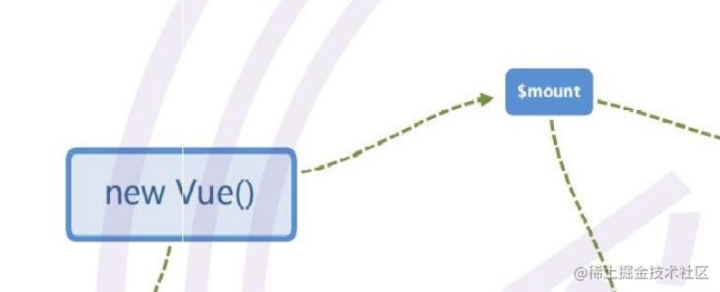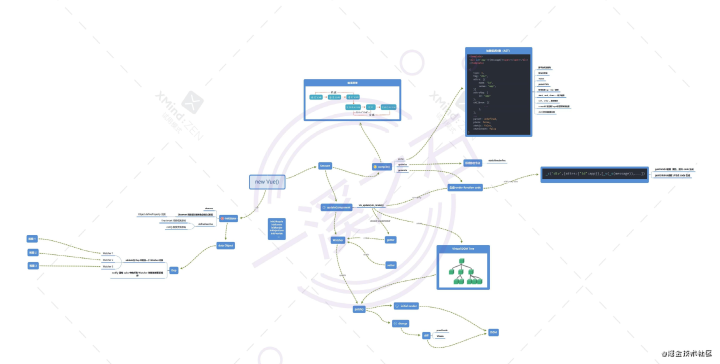Vue组件是怎样挂载的
我们先来关注一下$mount是实现什么功能的吧:

我们打开源码路径core/instance/init.js:
export function initMixin (Vue: Class<Component>) {......initLifecycle(vm)// 事件监听初始化initEvents(vm)initRender(vm)callHook(vm, 'beforeCreate')initInjections(vm) // resolve injections before data/props//初始化vm状态 prop/data/computed/watch完成初始化initState(vm)initProvide(vm) // resolve provide after data/propscallHook(vm, 'created')......// 配置项里有el属性, 则会挂载到真实DOM上, 完成视图的渲染// 这里的$mount方法,本质上调用了core/instance/liftcycle.js中的mountComponent方法if (vm.$options.el) {vm.$mount(vm.$options.el)}}
}
在这里我们怎么理解这个挂载状态呢?先来看Vue官方给的一段描述
- 如果
Vue实例在实例化时没有收到el选项,则它处于“未挂载”状态,没有关联的DOM元素。 - 可以使用
vm.$mount()手动地挂载一个未挂载的实例。 - 如果没有提供
elementOrSelector参数,模板将被渲染为文档之外的的元素。 - 并且你必须使用
原生DOM API把它插入文档中。
那我们来看一下$mount内部机制吧:
* 缓存之前的$mount的方法以便后面返回实例,*/
const mount = Vue.prototype.$mount
/** * 手动地挂载一个未挂载的根元素,并返回实例自身(Vue实例) */
Vue.prototype.$mount = function (el?: string | Element, hydrating?: boolean
): Component {el = el && query(el)/* istanbul ignore if *//** * 挂载对象不能为body和html标签 */if (el === document.body || el === document.documentElement) {process.env.NODE_ENV !== 'production' && warn(`Do not mount Vue to <html> or <body> - mount to normal elements instead.`)return this}const options = this.$options// resolve template/el and convert to render function/** * 判断$options是否有render方法 * 有:判断是String还是Element,获取他们的innerHTMl * 无:在实例Vue时候在vnode里创建一个创建一个空的注释节点 见方法createEmptyVNode */if (!options.render) {let template = options.templateif (template) {if (typeof template === 'string') {if (template.charAt(0) === '#') {template = idToTemplate(template)/* istanbul ignore if */if (process.env.NODE_ENV !== 'production' && !template) {warn(`Template element not found or is empty: ${options.template}`,this)}}/** * 获取的Element的类型 * 详细见 https://developer.mozilla.org/zh-CN/docs/Web/API/Element/outerHTML */} else if (template.nodeType) {template = template.innerHTML} else {if (process.env.NODE_ENV !== 'production') {warn('invalid template option:' + template, this)}return this}} else if (el) {template = getOuterHTML(el)}if (template) {/* istanbul ignore if *//** * 用于监控compile 的性能 */if (process.env.NODE_ENV !== 'production' && config.performance && mark) {mark('compile')}// 如果不存在 render 函数,则会将模板转换成render函数const { render, staticRenderFns } = compileToFunctions(template, {shouldDecodeNewlines,shouldDecodeNewlinesForHref,delimiters: options.delimiters,comments: options.comments}, this)options.render = renderoptions.staticRenderFns = staticRenderFns/* istanbul ignore if *//** * 用于监控compile 的性能 */if (process.env.NODE_ENV !== 'production' && config.performance && mark) {mark('compile end')measure(`vue ${this._name} compile`, 'compile', 'compile end')}}}return mount.call(this, el, hydrating)
}
而$mount实现的是mountComponent函数功能
// public mount method
Vue.prototype.$mount = function (el?: string | Element, hydrating?: boolean
): Component {el = el && inBrowser ? query(el) : undefinedreturn mountComponent(this, el, hydrating)
}
那么我们再去找一下mountComponent函数吧:
export function mountComponent (vm: Component,el: ?Element,hydrating?: boolean
): Component {vm.$el = el// 如果不存在render函数,则直接创建一个空的VNode节点if (!vm.$options.render) {vm.$options.render = createEmptyVNodeif (process.env.NODE_ENV !== 'production') {/* istanbul ignore if */if ((vm.$options.template && vm.$options.template.charAt(0) !== '#') ||vm.$options.el || el) {warn('You are using the runtime-only build of Vue where the template ' +'compiler is not available. Either pre-compile the templates into ' +'render functions, or use the compiler-included build.',vm)} else {warn('Failed to mount component: template or render function not defined.',vm)}}}// 检测完render后,开始调用beforeMount声明周期callHook(vm, 'beforeMount')let updateComponent/* istanbul ignore if */if (process.env.NODE_ENV !== 'production' && config.performance && mark) {updateComponent = () => {const name = vm._nameconst id = vm._uidconst startTag = `vue-perf-start:${id}`const endTag = `vue-perf-end:${id}`mark(startTag)const vnode = vm._render()mark(endTag)measure(`vue ${name} render`, startTag, endTag)mark(startTag)vm._update(vnode, hydrating)mark(endTag)measure(`vue ${name} patch`, startTag, endTag)}} else {updateComponent = () => {// 这里是上面所说的观察者,这里注意第二个expOrFn参数是一个函数// 会在new Watcher的时候通过get方法执行一次// 也就是会触发第一次Dom的更新vm._update(vm._render(), hydrating)}}vm._watcher = new Watcher(vm, updateComponent, noop, null, true /* isRenderWatcher */)hydrating = false//触发$mount函数if (vm.$vnode == null) {vm._isMounted = truecallHook(vm, 'mounted')}return vm
}
总结来说就是:
- 执行
vm._watcher = new Watcher(vm, updateComponent, noop)。 - 触发
Watcher里面的get方法,设置Dep.target = watcher。 - 执行
updateComponent。
这个过程中,会去读取我们绑定的数据,由于之前我们通过Observer进行了数据劫持,这样会触发数据的get方法。此时会将watcher添加到 对应的dep中。当有数据更新时,通过dep.notify()去通知到Watcher,然后执行Watcher中的update方法。此时又会去重新执行updateComponent,至此完成对视图的重新渲染。
我们着重关注一下vm._update(vm._render(), hydrating):
...let vnodetry {vnode = render.call(vm._renderProxy, vm.$createElement)} catch (e) {handleError(e, vm, `render`)// return error render result,// or previous vnode to prevent render error causing blank component/* istanbul ignore else */if (process.env.NODE_ENV !== 'production') {if (vm.$options.renderError) {try {vnode = vm.$options.renderError.call(vm._renderProxy, vm.$createElement, e)} catch (e) {handleError(e, vm, `renderError`)vnode = vm._vnode}} else {vnode = vm._vnode}} else {vnode = vm._vnode}}
我们看到有俩个方法vm._renderProxy代理vm,要来检测render是否用了vm上没有的属性与方法,用来报错,vm.$createElement则是创建VNode:
参考 前端进阶面试题详细解答
render: function (createElement) {return createElement('h1', '标题')
}
数据我们是知道怎么更新的,那么组件tamplate到真实dom是怎么更新的呢?

- 解析
tamplate生成字符串 render Function处理字符串生成VNodepatch diff算法处理VNode
